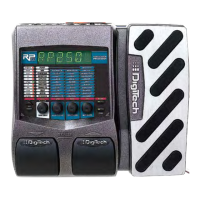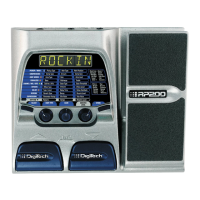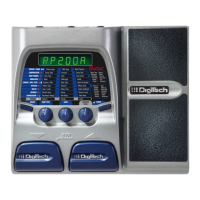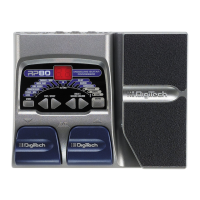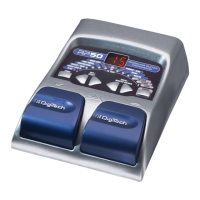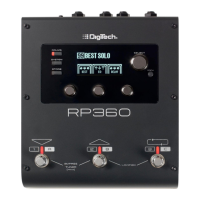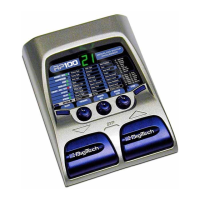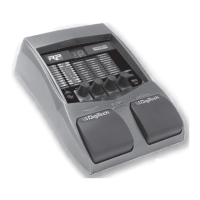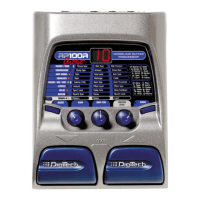Do you have a question about the DigiTech RP250 and is the answer not in the manual?
Crucial warnings for safe operation, including electrical shock and moisture avoidance.
Information regarding the device's compliance with EMC standards and recommended usage.
Formal statement confirming the product meets specified safety and EMC directives.
Details the limited warranty, coverage period, and consumer responsibilities for the RP250.
Overview of the RP250's capabilities and a list of included components.
Explains the primary modes of operation: Performance, Bypass for clean signal, and Tuner for tuning.
Details the functions of Tone, Effects, and Level knobs for sound selection and adjustment.
Information on using computer software for editing and managing RP250 presets.
Covers user/factory presets and using knobs for quick tone and effect loading.
Diagram and description of the RP250's main interface elements and controls.
Explains footswitch operations and the roles of Knobs 1 and 2 in various modes.
Details Knobs 3-4, Edit buttons for navigation, and the matrix display.
Covers display information, drum machine, and saving user presets.
Details real-time control via the expression pedal and its V-switch feature.
Diagram of rear panel jacks and description of the instrument input.
Optimizes output for guitar amps or mixer/recording devices.
Details connections for headphones, external audio, and computer interface.
Specifies the connection for the required power supply unit.
Instructions for connecting the RP250 to an amplifier for mono output.
Instructions for connecting the RP250 to two amplifiers or mixer channels for stereo output.
Guides for connecting to mixers and computers for recording via USB.
Step-by-step guide to safely power on the RP250 and connected amplifier.
Introduction to modifying presets and detailed steps for fine-tuning parameters.
Procedure for saving modified sounds and naming them using the alphanumeric display.
Using footswitches to choose the memory location for saving or copying presets.
Explains virtual amps/stompboxes and illustrates the model connection order.
Details Pickup models, Wah models, and their respective controls like Wah Minimum/Maximum.
Describes Compressor models (DIGCMP, SCOMP) and introduces Distortion models.
Lists distortion models and their specific knob functions for Gain, Tone, and Level.
Details selecting amp models, their inspirations, and the automatic cabinet selection.
Lists various amplifier models based on classic and modern gear.
Explains cabinet selection and adjustments for Amp Gain and Level.
Details EQ modes, Bass/Mid/Treble adjustments, and Noise Gate operation.
Describes the Chorus effect, its models, and parameters like Speed, Depth, and Level.
Details Flanger and Phaser effects, their models, and adjustment parameters.
Explains Vibrato modulation and Rotary Speaker emulation, including their respective controls.
Describes VibroPan (vibrato+panner), Tremolo (volume modulation), and Panner effects.
Details Envelope Filter, Auto Ya, and YaYa effects, controlling Wah-like and vocal characteristics.
Explains Step Filter and the DigiTech Whammy effect for pitch bending and harmonies.
Details Pitch Shifter for pitch changes and Detune for creating doubling effects.
Explains IPS for diatonic harmonies, covering shift, key, scale, and level parameters.
Covers Delay models (Analog, Digital, etc.) and parameters like Time, Repeats, and Level.
Explains reverb for acoustic simulation and lists Lexicon® reverb models.
Details reverb parameters like Decay, Liveliness, Reverb Level, and Predelay.
Introduction to the drum machine, its settings, and a list of available patterns.
Details using the Aux input and assigning parameters to the expression pedal.
Step-by-step instructions to restore the RP250 to its original factory settings.
Procedure to recalibrate the expression pedal after reset or if issues arise.
Lists key technical details: A/D converters, DSP, memory, and physical dimensions.
Details USB, computer requirements, and regional power specifications.
Table detailing parameters assignable to the expression pedal for various effects.
A list of all 60 Tone Library presets with their names and abbreviations.
A list of all 30 Effects Library presets, including combined effects.
A complete list of all 120 User and Factory presets with their names and abbreviations.
Crucial warnings for safe operation, including electrical shock and moisture avoidance.
Information regarding the device's compliance with EMC standards and recommended usage.
Formal statement confirming the product meets specified safety and EMC directives.
Details the limited warranty, coverage period, and consumer responsibilities for the RP250.
Overview of the RP250's capabilities and a list of included components.
Explains the primary modes of operation: Performance, Bypass for clean signal, and Tuner for tuning.
Details the functions of Tone, Effects, and Level knobs for sound selection and adjustment.
Information on using computer software for editing and managing RP250 presets.
Covers user/factory presets and using knobs for quick tone and effect loading.
Diagram and description of the RP250's main interface elements and controls.
Explains footswitch operations and the roles of Knobs 1 and 2 in various modes.
Details Knobs 3-4, Edit buttons for navigation, and the matrix display.
Covers display information, drum machine, and saving user presets.
Details real-time control via the expression pedal and its V-switch feature.
Diagram of rear panel jacks and description of the instrument input.
Optimizes output for guitar amps or mixer/recording devices.
Details connections for headphones, external audio, and computer interface.
Specifies the connection for the required power supply unit.
Instructions for connecting the RP250 to an amplifier for mono output.
Instructions for connecting the RP250 to two amplifiers or mixer channels for stereo output.
Guides for connecting to mixers and computers for recording via USB.
Step-by-step guide to safely power on the RP250 and connected amplifier.
Introduction to modifying presets and detailed steps for fine-tuning parameters.
Procedure for saving modified sounds and naming them using the alphanumeric display.
Using footswitches to choose the memory location for saving or copying presets.
Explains virtual amps/stompboxes and illustrates the model connection order.
Details Pickup models, Wah models, and their respective controls like Wah Minimum/Maximum.
Describes Compressor models (DIGCMP, SCOMP) and introduces Distortion models.
Lists distortion models and their specific knob functions for Gain, Tone, and Level.
Details selecting amp models, their inspirations, and the automatic cabinet selection.
Lists various amplifier models based on classic and modern gear.
Explains cabinet selection and adjustments for Amp Gain and Level.
Details EQ modes, Bass/Mid/Treble adjustments, and Noise Gate operation.
Describes the Chorus effect, its models, and parameters like Speed, Depth, and Level.
Details Flanger and Phaser effects, their models, and adjustment parameters.
Explains Vibrato modulation and Rotary Speaker emulation, including their respective controls.
Describes VibroPan (vibrato+panner), Tremolo (volume modulation), and Panner effects.
Details Envelope Filter, Auto Ya, and YaYa effects, controlling Wah-like and vocal characteristics.
Explains Step Filter and the DigiTech Whammy effect for pitch bending and harmonies.
Details Pitch Shifter for pitch changes and Detune for creating doubling effects.
Explains IPS for diatonic harmonies, covering shift, key, scale, and level parameters.
Covers Delay models (Analog, Digital, etc.) and parameters like Time, Repeats, and Level.
Explains reverb for acoustic simulation and lists Lexicon® reverb models.
Details reverb parameters like Decay, Liveliness, Reverb Level, and Predelay.
Introduction to the drum machine, its settings, and a list of available patterns.
Details using the Aux input and assigning parameters to the expression pedal.
Step-by-step instructions to restore the RP250 to its original factory settings.
Procedure to recalibrate the expression pedal after reset or if issues arise.
Lists key technical details: A/D converters, DSP, memory, and physical dimensions.
Details USB, computer requirements, and regional power specifications.
Table detailing parameters assignable to the expression pedal for various effects.
A list of all 60 Tone Library presets with their names and abbreviations.
A list of all 30 Effects Library presets, including combined effects.
A complete list of all 120 User and Factory presets with their names and abbreviations.
| Brand | DigiTech |
|---|---|
| Model | RP250 |
| Category | Music Pedal |
| Language | English |
